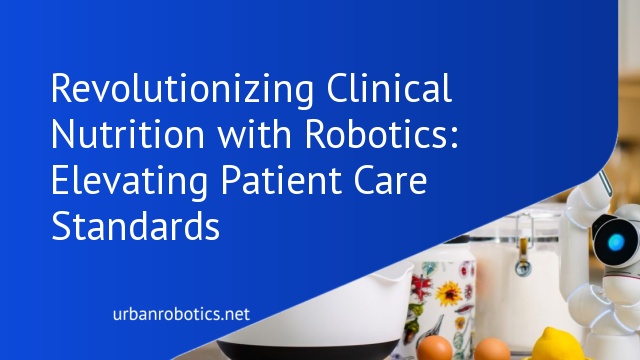Overview of Clinical Nutrition
Clinical nutrition focuses on patient-specific dietary needs. It involves assessing nutritional status, planning therapeutic diets, and monitoring outcomes. This field ensures patients receive the right nutrients to support recovery and overall health.
Dietitians and nutritionists assess nutrient deficiencies and metabolic conditions to tailor diets. Personalized nutrition addresses chronic illnesses like diabetes, cardiovascular diseases, and gastrointestinal disorders.
Tools used include dietary assessments, lab tests, and clinical evaluations. These tools help create effective nutrition plans suited to individual requirements. Our goal is to enhance patient health through precise nutrition strategies.
Emerging technologies, including robotics, are advancing clinical nutrition practices. They streamline processes like meal preparation, nutrient tracking, and patient feeding. Integrating robotics into clinical nutrition not only improves efficiency but also enhances patient care and outcomes.
The Role of Robotics in Healthcare
Robotics has become integral to healthcare, improving efficiency and patient care. These advancements are particularly impactful in clinical nutrition.
Evolution of Robotics in Medical Field
Robotics in healthcare has evolved from simple assistive devices to sophisticated systems enhancing many medical processes. Early uses included mechanical aids, while now robots perform complex surgeries, deliver medication, and assist in diagnostics. Examples include the da Vinci Surgical System for precision surgeries and robotic pharmacy dispensers. Continued innovation enhances functionality and application range.
Benefits of Robotics in Healthcare
Robotics offers numerous benefits in healthcare, including automation and precision. Automated systems reduce human error and increase consistency. Robots assist in tedious tasks, allowing healthcare providers to focus on critical patient care aspects. For instance, robotic-assisted feeding systems ensure accurate nutrient delivery, enhancing patient health and recovery.
Integration of Robotics in Clinical Nutrition
Integrating robotics in clinical nutrition offers innovative ways to enhance patient care. Robotics streamline nutritional assessments and meal preparation, ensuring patient-specific needs are met accurately.
Automated Dietary Assessment
Robotics use advanced algorithms to automate dietary assessments. By analyzing patient data from wearable devices and electronic health records, robots determine nutritional deficiencies and recommend dietary adjustments. For instance, they can track caloric intake, macronutrient distribution, and dietary patterns efficiently. This automation reduces the manual workload for nutritionists and improves the accuracy of dietary planning.
Robotic Assistance in Meal Preparation
Robots enhance meal preparation by ensuring precision and consistency. Automated systems can prepare meals tailored to specific dietary requirements, cooking techniques, and portion sizes. Examples include assembling ingredients for diabetic-friendly meals or tailoring dishes for cardiac patients. These systems minimize human error, save time, and ensure nutritional compliance, ultimately improving patient outcomes in clinical nutrition.
Case Studies and Real-world Applications
Clinical nutrition combined with robotics is transforming patient care. Various case studies highlight the successful implementation of these technologies.
Successful Implementations
Valley Hospital incorporates robotic systems to manage the dietary needs of patients with chronic conditions like diabetes. Their robots track blood sugar levels, recommending dietary changes. Another example, a pediatric hospital in New York, uses robots to prepare precisely portioned meals for children with dietary restrictions. These implementations show that incorporating robotics can enhance nutritional care accuracy and efficiency.
Challenges and Limitations
Robotic systems in clinical nutrition face challenges. Initial costs for implementing these systems can be high, limiting widespread adoption. Technical issues, such as system malfunctions or errors in data processing, also pose risks. Additionally, ensuring that robots can adapt to the unique nutritional needs of every patient remains a complex task. Overcoming these limitations is crucial for maximizing the benefits of robotic integration in clinical nutrition.
Future Prospects of Robotics in Clinical Nutrition
Advancements in robotics offer promising paths for transforming clinical nutrition. These innovations aim to improve patient outcomes and streamline healthcare processes.
Emerging Technologies
Robotics in clinical nutrition continues evolving with innovations like AI-driven robots, 3D food printers, and automated nutritional assessments. AI-driven robots analyze patient health data, making real-time dietary recommendations. 3D food printers create nutritionally balanced meals tailored to individual needs. Automated nutritional assessments ensure consistent monitoring and adjustments to patient diets, optimizing nutritional intake.
Potential for Personalized Nutrition
Robotics can significantly enhance personalized nutrition. AI algorithms process individual health data, designing customized meal plans. For example, diabetic patients receive diet adjustments based on blood sugar trends. Automated meal preparation ensures adherence to dietary restrictions, offering tailored solutions to meet unique nutritional needs. This personalized approach enhances patient engagement, positively impacting health and recovery rates.
Conclusion
Embracing robotics in clinical nutrition has the potential to revolutionize patient care. By leveraging advanced technologies like AI-driven robots and 3D food printers, we can provide personalized nutrition solutions that cater to individual health needs. These innovations not only enhance patient outcomes but also streamline healthcare processes, making them more efficient.
While challenges such as high costs and technical issues exist, the benefits far outweigh the drawbacks. As we continue to advance in this field, overcoming these obstacles will be crucial. The future of clinical nutrition looks promising with robotics at the helm, offering a new era of precision and personalization in healthcare.





